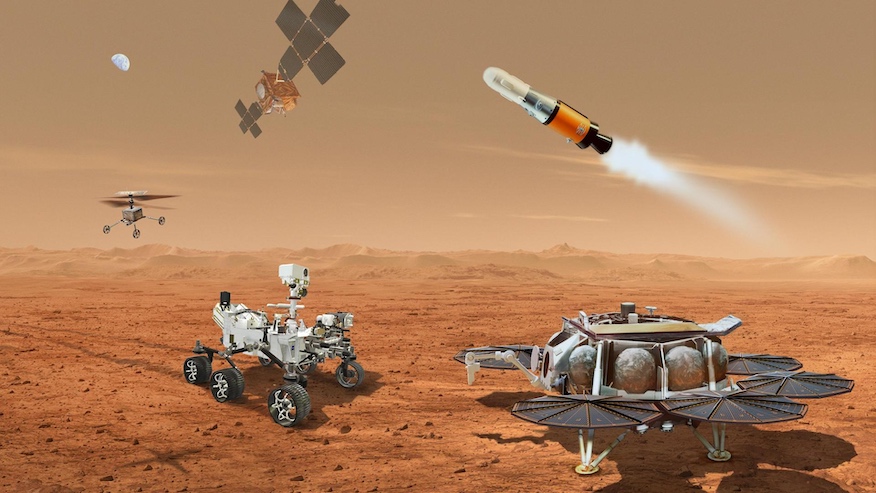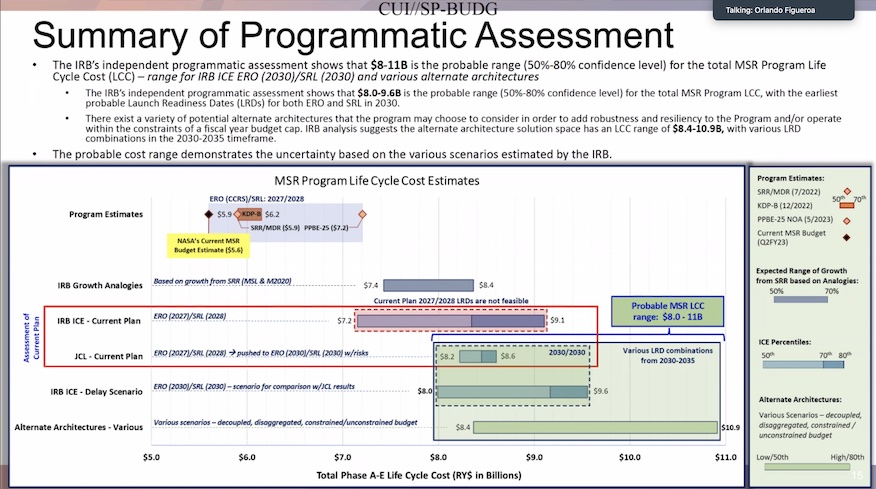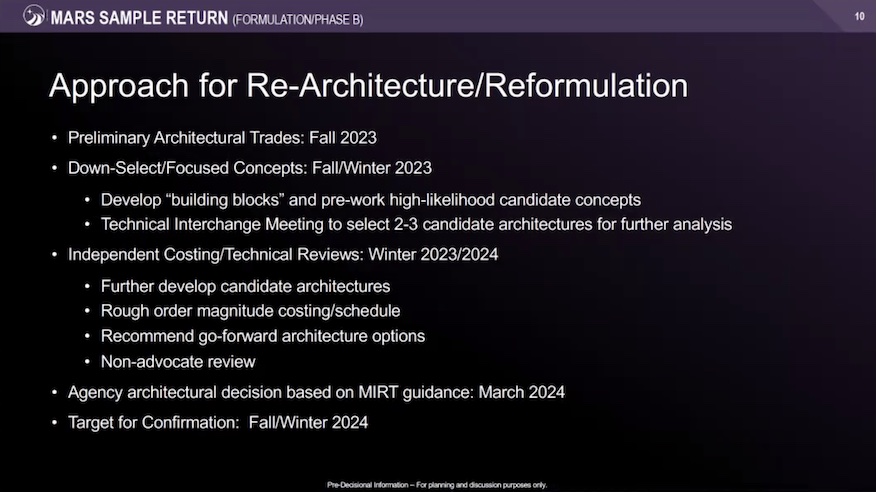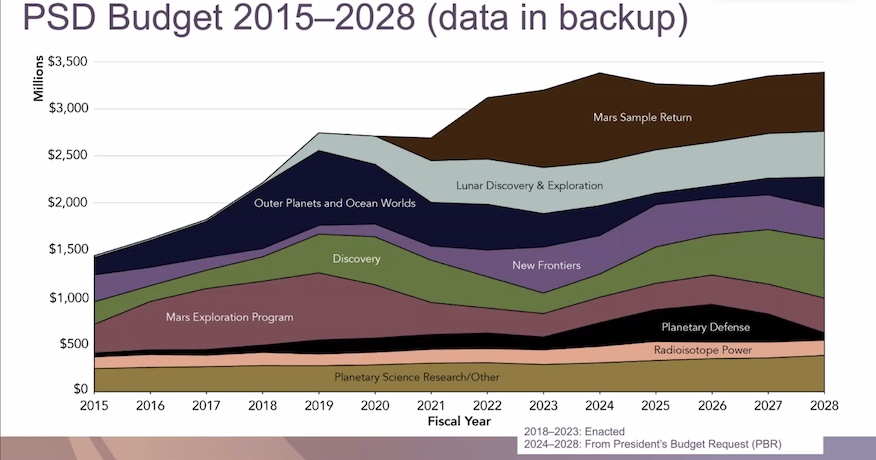Space News & Blog Articles
NASA begins to chart path forward on its Mars Sample Return architecture following independent review
 This illustration shows a concept for multiple robots that would team up to ferry to Earth samples of rocks and soil being collected from the Martian surface by NASA’s Mars Perseverance rover.
This illustration shows a concept for multiple robots that would team up to ferry to Earth samples of rocks and soil being collected from the Martian surface by NASA’s Mars Perseverance rover.Credit: NASA/ESA/JPL-Caltech
The next decade will be a critical time for the exploration of Mars with the multi-agency Mars Sample Return (MSR) being the marquee mission. The undertaking has been decades in the making, but an independent review of the MSR architecture raised some key questions about the feasibility and cost.
An overview of that report and how NASA intends to respond to it was the focus of the fall meeting of the Mars Exploration Program Analysis Group (MEPAG) Steering Committee (SC). Members met virtually on Friday, Oct. 20, to discuss the findings.
“The entire planetary science community sees the value of sample return as a means of addressing high priority science in the solar system,” said Dr. Vicky Hamilton, the current SC chair and planetary geologist at the Southwest Research Institute. “And while the MSR may be the first mission that would demonstrate the feasibility of robotically selecting and returning samples, it’s not the only destination.”
“That said, independent of the scientific value of sample return, there are of course practical realities. And I think that’s really why we’re here today (Friday) and that is because doing sample return is hard,” Hamilton added. “There are technological hurdles, it’s going to cost more money than we’re accustomed to spending on the average Mars mission and there may be changes to what we’ve become used to as our Mars Exploration Program.”
MSR will rely on components from both NASA and the European Space Agency (ESA) among others. In May 2023, NASA established its second Independent Review Board (IRB-2) to comb through its portion of the plan and create a third-party evaluation of the costs, technical saliency and the schedule set forth by NASA to make it all happen.
 A roadmap of the Mars samples collected by the Perseverance rover. Credit: NASA
A roadmap of the Mars samples collected by the Perseverance rover. Credit: NASA
During his remarks on Friday, Orlando Figueroa, the IRB-2 chair, noted that this committee was formed in part because the former MSR plans evaluated by the IRB-1 (chartered in 2020) were found to be “virtually non-executable.”
“Technical issues indicated to us that the early planning dates for a ’27 or ’28 launch were simply not credible, a near zero probability that we’d be able to do it,” Figueroa said. “Moving to 2030 offers an opportunity, and looks it is possible, but the President’s budget doesn’t quite support that.”
Figueroa pointed to one of the key challenges for MSR: budgeting. As he referenced, the Biden Administration’s proposal for NASA’s budget in FY24 included about $3.4 billion for Planetary Science, a roughly 5.7 percent increase from FY23 funding levels.
Of that, MSR would be allotted $949 million, up from $822.3 million the previous year. But with the one, two punch of ballooning mission costs and a Congress that could either freeze spending at FY23 levels or reduce spending further current cost estimates are likely to pose a big challenge.
The IRB-2 report noted that in order to hit a Launch Readiness Date (LRD) in 2030 for both the Sample Retrieval Lander (SRL) and the Earth Return Orbiter (ERO), they would need to spend between $8-9.6 billion “with funding in excess of $1 billion per year to be required for three or more years starting in 2025.”
“This pushes the experience base of SMD (Science Mission Directorate). [James Webb Space Telescope] is the only large mission or flagship mission of this kind that required high levels of funding, but never exceeded $1 billion,” Figueroa said. “So, this puts a lot of stress on SMD, unless there is a relief valve provided somewhere and thus, one of the reasons for the recommendation for the agency to look at what other options may be available.”
 A slide from Orlando Figueroa’s discussion of the Independent Review Board’s assessment of the Mars Sample Return program. Credit: NASA
A slide from Orlando Figueroa’s discussion of the Independent Review Board’s assessment of the Mars Sample Return program. Credit: NASA
One of the options, Figueroa said, would be to put the launches of the SRL and the ERO on track for separate dates.
Currently, the MSR architecture consists of four main buckets:
Mars 2020/Perseverance Sample collection and storage Sample Retrieval Lander (SRL) & Mars Ascent Vehicle (MAV) Retrieve the collected samples and launch them into Mars orbit Earth Return Orbiter (ERO) & Capture Containment and Return System (CCRS) Capture and hold onto samples in Mars orbit, undergo decontamination and return samples to Earth Sample Receiving Project Recover the samples on Earth and contain them for initial sample science and curationAnother suggestion in the report is to pass off the responsibility for ERO to the European Space Agency, noting that “This arrangement will allow [Goddard Space Flight Center] to work with ESA and Airbus without going through [Jet Propulsion Lab].”
“Alternative architectures, I alluded to them in the programmatic analysis, they should be examined with clear guidelines provided by NASA headquarters for what is a reasonable and realistic yearly budget constraint, once again acknowledging that the price tag of all the options that we examine were in the $8-11 billion range regardless of architectural choices,” Figueroa said.
“It may be closer to the lower end or to the upper end, depending on those decisions, but it behooves the agency to look at it carefully, so that you can come up with a realistic, technical and programmatic plan,” he added. “In our view, this mission should not be baselined until those things are resolved because otherwise, everyone is living under unrealistic expectations. That’s what put us in this situation to begin with.”

Managing great expectations
NASA has quite a bit of headwind to face when it comes to charting a path forward on MSR. Sandra Connelly, the deputy associate administrator for NASA’s Science Mission Directorate, reiterated in her comments that the mission remains a high priority for NASA and stated that in 2024, the agency would “determine the budget alignment for the sustainable program.”
“It does need to be sustainable fro ma cost, schedule and technical perspective and ultimately, we’re gonna focus on our partnerships with ESA and we need to make sure we have buy in across the board,” Connelly said.
Jeff Gramling, the MSR Program Director, said as they navigate unknown budget constraints for FY24, they are bringing Steve Tebow from the Applied Physics Lab (APL) to be the chief engineer at the headquarters level.
“He brings fresh eyes and he’s the one that’s leading the integrated team. As we go off and look at ways to not only add resiliency as Orlando spoke about, but how we also look at whether there are ways we can reduce cost,” Gramling said. “Orlando and his team, for instance, explicitly said we need to look at mission element phasing, for instance, to live within annual funding constraints. That’s something we’ll be looking at.”
Dr. Lori Glaze, the director of NASA’s Science Mission Directorate’s Planetary Science Division, emphasized that gaining access to pristine samples from Mars is important towards the goal of studying the current or former presence of water as well as searching for signs of life.
While discussing the funding challenges that PSD faces, Glaze said they would endeavor to stick to the guidance of the decadal report and not let the MSR costs exceed 35 percent of that office’s budget.

“I actually find that guidance to be not only really practical, but really useful. It’s certainly something that Jeff Gramling and myself, in collaboration with Nicky Fox and Sandra at the SMD level, have really kept in mind as we think about, you know, how are we going to achieve and execute Mars Sample Return so that it doesn’t impact, in a negative way, the rest of the planetary portfolio,” Glaze said.
She added that an important job for them is to keep what she termed “confirmed missions” on track. Those missions that have passed confirmation reviews include Psyche, Europa Clipper, VIPER and the Near Earth Objects (NEO) Surveyor missions. She said those are ones that have agreements with Congress on both cost and schedule.
Glaze said they are also trying to protect the research and analysis programs’ budget as they consider cost-cutting efforts. She reiterated a point from August that if the tighter federal budgets come to fruition, the New Frontiers program’s Announcement of Opportunity (AO) would slip to no earlier than 2026.
“Discovery and SIMPLEx are also unlikely to be offered as long as these budgets are really tight. So, unlikely to come out over the next couple of years,” Glaze said.
Connelly said NASA intends to respond to the recommendations of the IRB-2 report by the end of March 2024.
When you subscribe to the SpaceZE News Feed, we will send you an e-mail when there are new updates on the site so you wouldn't miss them.

